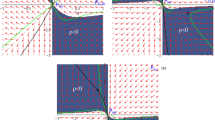Abstract
The main purpose of our paper is to construct a viable Kaluza-Klein model satisfying the observational constraints. To this end, we investigate a six-dimensional model with spherical compactification of the internal space. Background matter is considered in the form of a perfect fluid with nonlinear equations of state both in the external/our and internal spaces, and the model is set to include an additional bare cosmological constant Λ6. In the weak-field approximation, the background is perturbed by a pressureless gravitating mass that is a static pointlike particle. The nonlinearity of the equations of state of the perfect fluid makes it possible to solve simultaneously a number of problems. The requirement that the post-Newtonian parameter γ be equal to 1 in this configuration, first, ensures compatibility with the gravitational tests in the Solar system (deflection of light and time delay of radar echoes) at the same level of accuracy as General Relativity. Second, it translates into the absence of internal space variations, so that the gravitational potential exactly coincides with the Newtonian one, securing the absence of a fifth force. Third, the gravitating mass remains pressureless in the external space, as in the standard approach to nonrelativistic astrophysical objects and, meanwhile, acquires an effective tension in the internal space.
Similar content being viewed by others
References
Th. Kaluza, “Zum Unitätsproblem der Physik,” Sitzungsber. d. Preuss. Akad. d. Wiss. 966-972 (1921); O. Klein, “Quantentheorie and funfdimen-sionale Relativitatstheorie,” Zeitschrift für Physik 37, 895-906 (1926).
J. Polchinski, String Theory, Volume 2: Super-string Theory and Beyond (Cambridge University Press, Cambridge, 1998).
U. Günther, A. Starobinsky, and A. Zhuk, “Multidimensional cosmological models: cosmological and astrophysical implications and constraints,” Phys. Rev. D 69, 044003(2004); hep-ph/0306191.
N. Arkani-Hamed, S. Dimopoulos, and G. Dvali, “Phenomenology, astrophysics, and cosmology of theories with submillimeter dimensions and TeV scale quantum gravity,” Phys. Rev. D 59, 086004 (1999); hep-ph/9807344.
M. Eingorn and A. Zhuk, “Classical tests of multidimensional gravity: negative result,” Class. Quantum Grav. 27, 205014 (2010); arXiv: 1003.5690.
M. Eingorn and A. Zhuk, “Kaluza-Klein models: can we construct a viable example?,” Phys. Rev. D 83, 044005 (2011); arXiv: 1010.5740.
M. Eingorn, O. Medeiros, L. Crispino, and A. Zhuk, “Latent solitons, black strings, black branes, and equations of state in Kaluza-Klein models,” Phys. Rev. D 84, 024031 (2011); arXiv: 1101.3910.
A. Chopovsky, M. Eingorn, and A. Zhuk, “Weak-field limit of Kaluza-Klein models with spherical compactification: experimental constraints,” Phys. Rev. D 85, 064028 (2012); arXiv: 1107.3388.
A. Chopovsky, M. Eingorn, and A. Zhuk, “Exact and asymptotic black branes with spherical compactification,” Phys. Rev. D 86, 024025 (2012); arXiv: 1202.2677.
M. Eingorn, S. H. Fakhr, and A. Zhuk, “Kaluza-Klein models with spherical compactification: observational constraints and possible examples,” Class. Quantum Grav. 30, 115004 (2013); arXiv: 1209.4501.
A. Chopovsky, M. Eingorn, and A. Zhuk, “Problematic aspects of Kaluza-Klein excitations in multidimensional models with Einstein internal spaces,” Phys. Lett. B 736, 329(2014); arXiv: 1402.1340.
O. Akarsu, A. Chopovsky, and A. Zhuk, “Black branes and black strings in the astrophysical and cosmological context,” Phys. Lett. B 778, 190 (2018); arXiv: 1711.08372.
M. Eingorn and A. Zhuk, “Remarks on gravitational interaction in Kaluza-Klein models,” Phys. Lett. B 713, 154(2012); arXiv: 1201.1756.
M. Eingorn and A. Zhuk, “Significance of tension for gravitating masses in Kaluza-Klein models,” Phys. Lett. B 716, 176(2012); arXiv: 1202.4773.
C. M. Will, Theory and Experiment in Gravitational Physics (Cambridge University Press, Cambridge, 2000).
L. D. Landau and E. M. Lifshitz, The Classical Theory of Fields, Fourth Edition: Volume 2 (Course of Theoretical Physics Series (Pergamon Press, Oxford, 2000).
Acknowledgments
The authors are grateful to Maxim Eingorn for stimulating discussions and valuable comments.
Author information
Authors and Affiliations
Corresponding authors
Additional information
The present issue of the journal is No. 100 since it was founded in 1995.
Rights and permissions
About this article
Cite this article
Yalçınkaya, E., Zhuk, A. Weak-Field Limit of a Kaluza-Klein Model with a Nonlinear Perfect Fluid. Gravit. Cosmol. 25, 349–353 (2019). https://doi.org/10.1134/S0202289319040145
Received:
Revised:
Accepted:
Published:
Issue Date:
DOI: https://doi.org/10.1134/S0202289319040145




